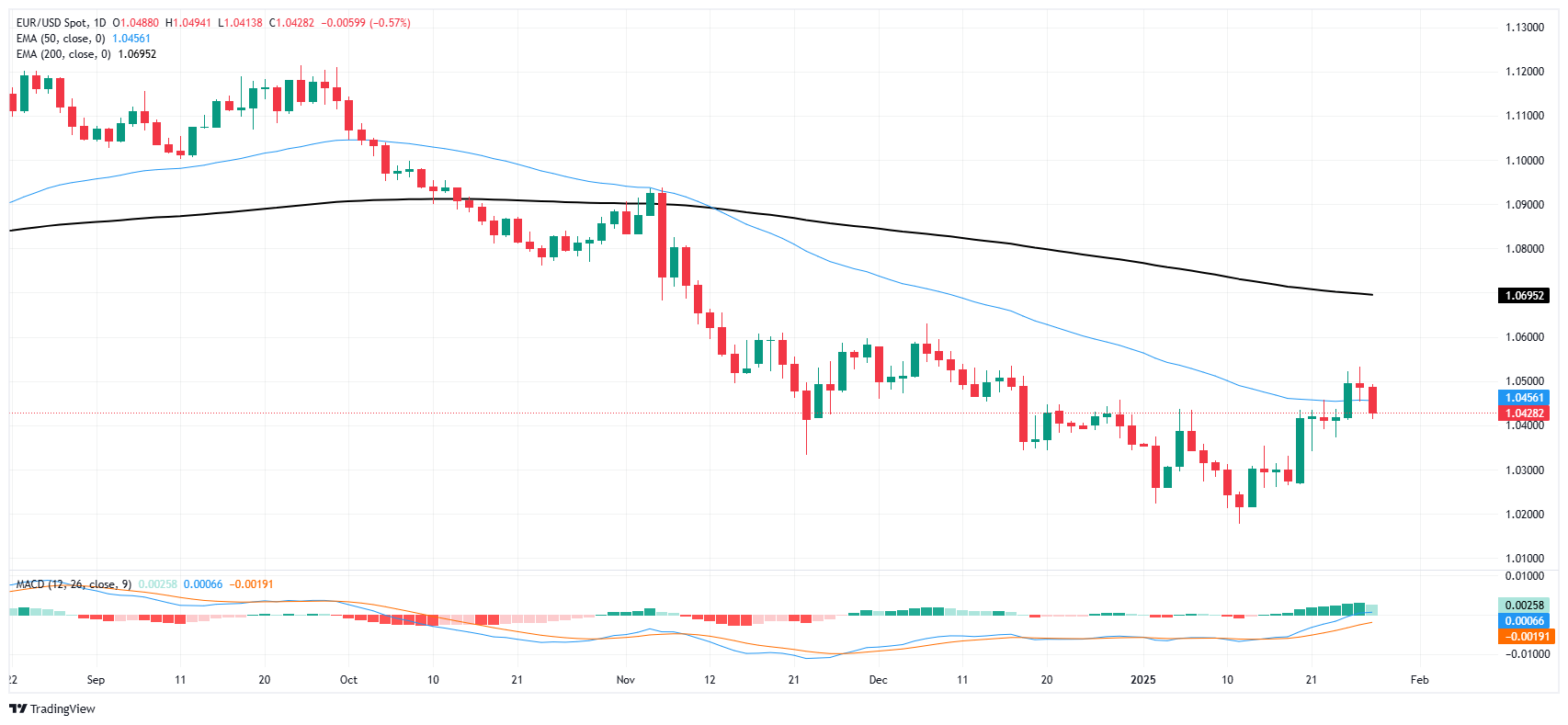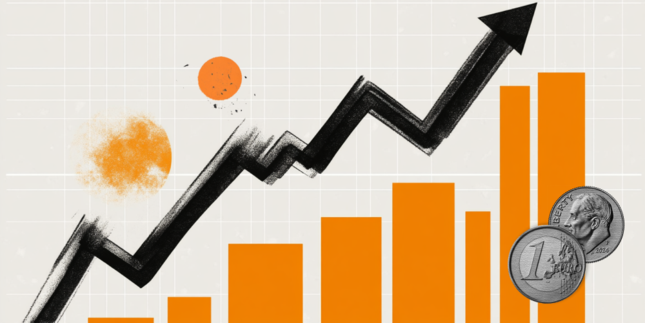- EUR/USD shed 0.6% on Tuesday as market sentiment pulls back.
- Latest Fed rate call expected to be a hold, investors waiting to see changes in narrative.
- Tariff threats continue to hang over trader risk appetite, keeping Greenback bid.
EUR/USD pared recent gains on Tuesday, shedding six-tenths of one percent and inching back toward the 1.0400 handle as markets gear up for another outing from the Federal Reserve (Fed) on Wednesday. Markets are overwhelmingly expecting a flat rate hold from the Fed in January, but investors will be keeping a close eye on not only Fed Chair Jerome Powell’s press conference, but any tweets from US President Donald Trump.
The economic calendar is lacking any meaningful data on the European side for the front half of the week. Fiber traders will have to wait until Thursday’s Gross Domestic Product (GDP) updates from both Germany and the pan-EU area for the fourth quarter.
Late Monday, US President Donald Trump swiftly resumed his aggressive tariff agenda, reiterating his intention to impose hefty import fees on a broad spectrum of foreign goods and industries. This latest version of his plan involves vague tariffs on steel, copper, aluminum, various semiconductors, and foreign microprocessors in general, aimed at compelling foreign businesses to relocate their factories to the US.
Persuading these sectors to shift production domestically is a challenging task, as establishing factories in the US is typically costly, and US labor demands significantly higher wages compared to countries that produce industrial goods on a large scale. As a result, import fees are unlikely to influence production decisions significantly; instead, they may lead to inflation and reduced consumer spending.
The Federal Reserve is expected to announce its latest interest rate decision on Wednesday. While no change in the fed funds rate is anticipated this week, traders will closely watch for updates on the ongoing tensions between Fed Chair Jerome Powell and President Trump. The Fed's considerable autonomy limits the White House's influence over interest rates, a situation President Trump has expressed frustration about in the past. Trump’s recent claims that he will “demand” lower interest rates are expected to impact Chair Powell’s upcoming press conference.
EUR/USD price forecast
The Euro’s backslide against the Greenback on Tuesday puts the Fiber in a tenuous technical scenario: a bearish turnaround in EUR/USD bids is forming a technical rejection from the 50-day Exponential Moving Average (EMA) declining into 1.0460. The pair is poised for further losses on a technical basis, unless bidders are able to muscle price action back into the green and on a path toward the 200-day EMA, floating just south of the 1.0700 handle.
EUR/USD daily chart
Euro FAQs
The Euro is the currency for the 19 European Union countries that belong to the Eurozone. It is the second most heavily traded currency in the world behind the US Dollar. In 2022, it accounted for 31% of all foreign exchange transactions, with an average daily turnover of over $2.2 trillion a day. EUR/USD is the most heavily traded currency pair in the world, accounting for an estimated 30% off all transactions, followed by EUR/JPY (4%), EUR/GBP (3%) and EUR/AUD (2%).
The European Central Bank (ECB) in Frankfurt, Germany, is the reserve bank for the Eurozone. The ECB sets interest rates and manages monetary policy. The ECB’s primary mandate is to maintain price stability, which means either controlling inflation or stimulating growth. Its primary tool is the raising or lowering of interest rates. Relatively high interest rates – or the expectation of higher rates – will usually benefit the Euro and vice versa. The ECB Governing Council makes monetary policy decisions at meetings held eight times a year. Decisions are made by heads of the Eurozone national banks and six permanent members, including the President of the ECB, Christine Lagarde.
Eurozone inflation data, measured by the Harmonized Index of Consumer Prices (HICP), is an important econometric for the Euro. If inflation rises more than expected, especially if above the ECB’s 2% target, it obliges the ECB to raise interest rates to bring it back under control. Relatively high interest rates compared to its counterparts will usually benefit the Euro, as it makes the region more attractive as a place for global investors to park their money.
Data releases gauge the health of the economy and can impact on the Euro. Indicators such as GDP, Manufacturing and Services PMIs, employment, and consumer sentiment surveys can all influence the direction of the single currency. A strong economy is good for the Euro. Not only does it attract more foreign investment but it may encourage the ECB to put up interest rates, which will directly strengthen the Euro. Otherwise, if economic data is weak, the Euro is likely to fall. Economic data for the four largest economies in the euro area (Germany, France, Italy and Spain) are especially significant, as they account for 75% of the Eurozone’s economy.
Another significant data release for the Euro is the Trade Balance. This indicator measures the difference between what a country earns from its exports and what it spends on imports over a given period. If a country produces highly sought after exports then its currency will gain in value purely from the extra demand created from foreign buyers seeking to purchase these goods. Therefore, a positive net Trade Balance strengthens a currency and vice versa for a negative balance.
Information on these pages contains forward-looking statements that involve risks and uncertainties. Markets and instruments profiled on this page are for informational purposes only and should not in any way come across as a recommendation to buy or sell in these assets. You should do your own thorough research before making any investment decisions. FXStreet does not in any way guarantee that this information is free from mistakes, errors, or material misstatements. It also does not guarantee that this information is of a timely nature. Investing in Open Markets involves a great deal of risk, including the loss of all or a portion of your investment, as well as emotional distress. All risks, losses and costs associated with investing, including total loss of principal, are your responsibility. The views and opinions expressed in this article are those of the authors and do not necessarily reflect the official policy or position of FXStreet nor its advertisers. The author will not be held responsible for information that is found at the end of links posted on this page.
If not otherwise explicitly mentioned in the body of the article, at the time of writing, the author has no position in any stock mentioned in this article and no business relationship with any company mentioned. The author has not received compensation for writing this article, other than from FXStreet.
FXStreet and the author do not provide personalized recommendations. The author makes no representations as to the accuracy, completeness, or suitability of this information. FXStreet and the author will not be liable for any errors, omissions or any losses, injuries or damages arising from this information and its display or use. Errors and omissions excepted.
The author and FXStreet are not registered investment advisors and nothing in this article is intended to be investment advice.
Recommended content
Editors’ Picks

GBP/USD climbs above 1.2500 after UK GDP data
GBP/USD gathers bullish momentum and trades above 1.2500 in the European session on Thursday. Pound Sterling benefits from the improving risk mood and the upbeat UK data, which showed that the economy expanded at an annual rate of 1.4% in Q4, surpassing the market expectation of 1.1%.

EUR/USD stays strongly bid toward 1.0450 ahead of EU data
EUR/USD continues its upward momentum for the third straight session, eyeing 1.0450 in the European session on Thursday. The pair draws support from the unabated US Dollar selling in anticipation of an end to the Russia-Ukraine war. EU and US data also remain in focus.

Gold price builds on steady intraday ascent amid trade war fears and weaker USD
Gold price attracts buyers for the second straight day amid a combination of supportive factors. Concerns about Trump’s trade tariff and a modest USD weakness underpin the XAU/USD pair.

Ripple's XRP eyes a recovery as investors switch toward accumulation
Ripple's XRP is up 2% in the early Asian session on Thursday following rising accumulation among investors and a potential bottom signal in the MVRV Ratio.

How the European Union could counter US tariffs
With Trump ordering a 25% import tax on all steel and aluminium entering the US, trade tensions are inching closer to Europe. We take a closer look at how European policymakers could react. Spoiler alert: it's complicated.

The Best Brokers of the Year
SPONSORED Explore top-quality choices worldwide and locally. Compare key features like spreads, leverage, and platforms. Find the right broker for your needs, whether trading CFDs, Forex pairs like EUR/USD, or commodities like Gold.